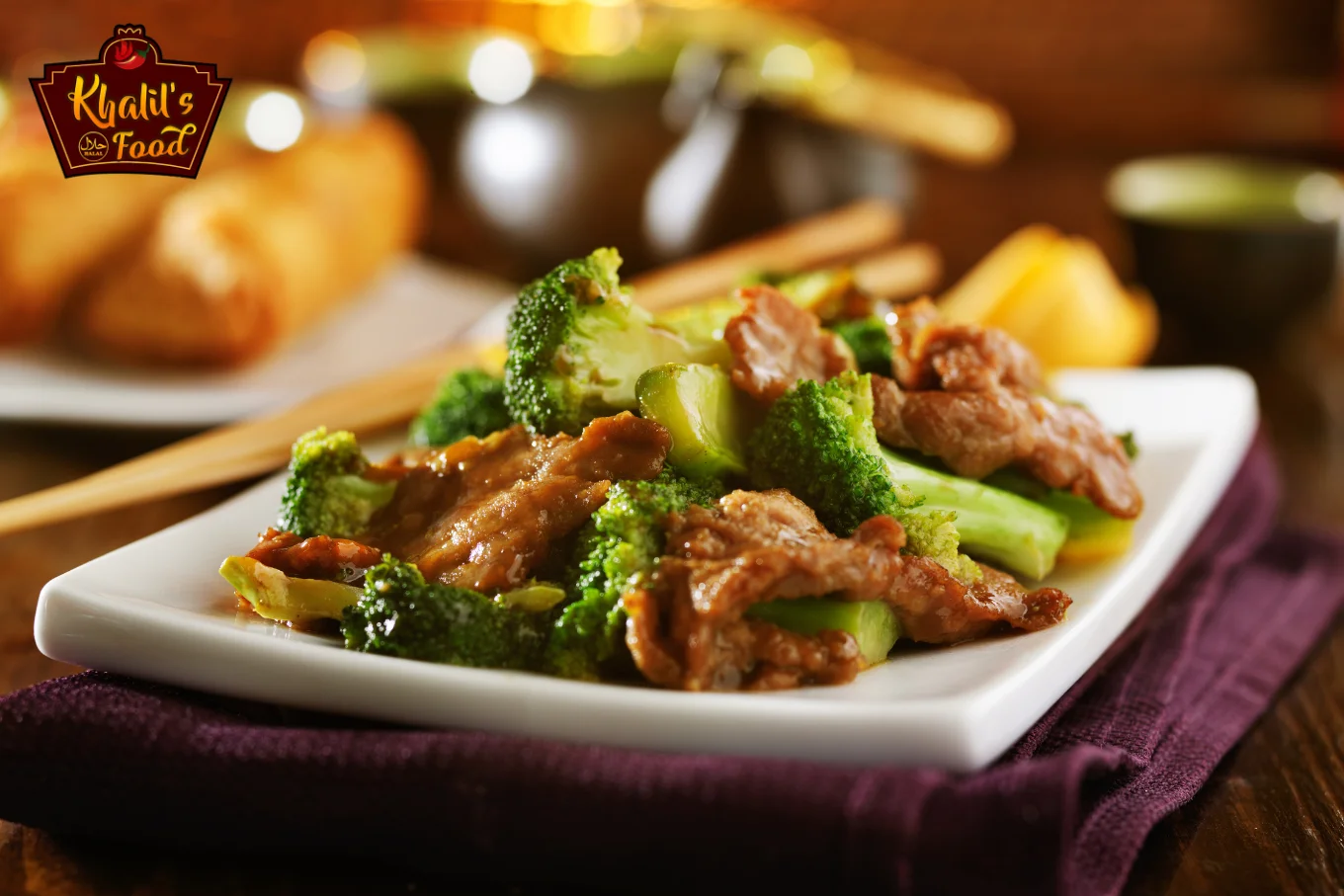If you’ve ever sat down at your favorite Chinese restaurant and marveled at the tender beef, crisp vegetables, and savory sauce in a hot, sizzling stir-fry, you’re not alone. Chinese beef and mixed vegetables is a favorite around the world. It’s a perfect mix of protein, crunch, and bold flavor — and the best part? You can make it at home, fresh, fast, and better than takeout.
At Khalil’s Food, we love bringing real Chinese stir-fry cooking to your kitchen. This guide will show you how to make Chinese beef and vegetables the right way — using easy-to-find ingredients and simple techniques. Whether you’re new to stir-frying or already comfortable in the kitchen, this recipe will quickly become a favorite.
Why This Dish Is a Staple in Chinese Cuisine
Chinese beef and mixed vegetables is more than a popular takeout order. It comes from a long history of stir-frying, a fast, high-heat cooking style that started back in the Han dynasty. Stir-frying is all about speed, timing, and keeping ingredients crisp, colorful, and full of flavor.
This dish shows the balance that’s so important in Chinese cooking — tender beef, fresh vegetables, and bold sauces working together in harmony. Different regions like Canton and Sichuan have their own spins, from sweet and garlicky to bold and spicy versions.
Today, it’s still a go-to meal because it’s quick to make, healthy, and packed with flavor — everything you want in a weekday dinner.
The Key Ingredients You’ll Need (And Why They Matter)
You don’t need anything fancy to make this dish — just a few fresh ingredients that really count.
Start with the right beef. Flank steak is a top choice because it’s lean, flavorful, and gets tender when sliced thin. Other great options are sirloin, flat iron, or skirt steak.
For vegetables, go with a mix of crunchy and colorful ones: broccoli, bell peppers, carrots, snow peas, baby corn, mushrooms, bok choy, and onion. These soak up the sauce and keep their texture after cooking.
Don’t forget the aromatics — garlic, ginger, and green onions are key. The sauce usually includes soy sauce, oyster sauce, sugar, sesame oil, and a bit of cornstarch to give it that shiny, rich coating you expect from a great stir-fry.
The Best Vegetables for Chinese Stir-Fry
The best vegetables for this dish are ones that stay crisp and don’t get soggy.
Broccoli, snap peas, and carrots are perfect for their crunch. Bell peppers bring color and sweetness. Mushrooms and bok choy add moisture and earthiness. For a more traditional feel, try baby corn or water chestnuts.
Cut all your vegetables to the same size so they cook evenly. You don’t need ten different kinds — even three or four well-chosen vegetables can make a great stir-fry. It’s all about balance in color, taste, and texture.
How to Choose the Right Cut of Beef for Stir-Frying
The cut of beef you choose makes a big difference. Flank steak is a favorite because it’s easy to slice thin, so it cooks quickly and stays tender. Make sure to cut against the grain — this shortens the muscle fibers and makes the beef less chewy.
Sirloin and flat iron are great too. Just avoid tougher cuts like chuck or brisket, which need longer cooking.
Most important: marinate the beef. It boosts flavor and helps the meat stay juicy and soft.
Mastering the Marinade: Flavor and Tenderness
A good marinade turns ordinary beef into something special.
The basic mix includes soy sauce, Shaoxing wine (or dry sherry), cornstarch, and a small amount of baking soda. The cornstarch locks in moisture and gives a velvety texture. The baking soda helps break down the beef’s fibers for extra tenderness.
You only need 15–30 minutes of marinating time, but longer is better if you can plan ahead. You can even slice and marinate the beef ahead of time, freeze it in portions, and cook it straight from frozen when you’re in a rush.
Sauce Secrets – Making the Perfect Stir-Fry Sauce
The sauce is what pulls everything together.
Start with soy sauce for saltiness, oyster sauce for rich flavor, and a touch of sugar or hoisin to balance it out. A bit of sesame oil adds depth, and chicken broth makes it smooth. To thicken it, stir in a simple cornstarch slurry (cornstarch + water).
If you like a little kick, add chili paste. Want it tangy? A splash of rice vinegar works great.
Cook the beef and vegetables first, then add the sauce. That way, the sauce brings everything together without making the veggies mushy.
Tools You’ll Need: Wok vs Skillet vs Non-Stick
A carbon steel wok is the best tool for stir-frying. It heats up fast, cooks evenly, and gives that slight smoky flavor known as “wok hei.”
But if you don’t have a wok, that’s okay. A large stainless-steel or cast-iron skillet works well too. Just avoid non-stick pans — they don’t handle high heat well and won’t sear the meat properly.
Whatever pan you use, make sure it’s very hot before adding oil or ingredients. The heat is what makes a stir-fry shine.
Step-by-Step: Cooking Chinese Beef and Mixed Vegetables
Here’s how to bring it all together:
- Heat your pan until it’s just starting to smoke.
- Add oil — peanut or avocado oil works well.
- Sear the beef in batches so it browns instead of steaming. Remove and set aside.
- Stir-fry the vegetables, starting with the ones that take longest to cook.
- Add garlic and ginger near the end so they don’t burn.
- Return the beef, pour in the sauce, and stir until everything’s coated and glossy.
- Finish with a splash of sesame oil and some chopped green onions.
You now have a fast, fresh, and flavorful Chinese stir-fry — ready in minutes.
Time-Saving Tips for Busy Home Cooks
If your evenings are rushed, here’s how to stay on track:
- Slice your veggies a few days ahead and store them in containers.
- Marinate the beef in the morning or even the night before.
- Mix the sauce and keep it in a jar in the fridge — it’ll stay good for a week.
Batch cooking is another time-saver. Double the recipe and pack half for lunch the next day. It heats up well and tastes just as good.
Healthier Stir-Fry Tweaks Without Losing Flavor
Want to make this dish even healthier?
- Use low-sodium soy sauce.
- Swap in tamari if you need it gluten-free.
- Skip the rice and serve with extra veggies or cauliflower rice for fewer carbs.
When you make it at home, you control everything — so you can keep the flavor and leave out anything you don’t want.
Regional & Global Variations to Try
This dish can be switched up in fun ways:
- For a Sichuan twist, add dried red chilies and chili oil.
- A Cantonese version might include straw mushrooms and a slightly sweeter sauce.
- Japanese-style beef stir-fry often uses mirin and soy sauce instead of oyster sauce.
Each version is unique, but the basics stay the same — quick-cooked beef, crisp veggies, and a great sauce.
What to Serve With Chinese Beef and Mixed Vegetables
Keep it simple with a side of jasmine rice, brown rice, or fried rice. You can also serve it with noodles, or spoon it into lettuce cups for a light option like a vegetable roll sushi recipe.
Appetizers like authentic chicken samosas, spring rolls, or wonton soup pair nicely without stealing the spotlight. For drinks, try hot jasmine tea or a chilled oolong.
Storage, Reheating, and Meal Prep Tips
Leftovers? No problem.
Store in an airtight container in the fridge for up to three days. To reheat, use a skillet with a splash of broth or water. This keeps the sauce smooth and prevents the beef from drying out. Avoid microwaving if you want to keep that fresh taste and texture.
For meal prep, pack cooked stir-fry with rice or noodles in containers. It makes an easy, balanced lunch.
Chinese Beef and Mixed Vegetables – Common Mistakes to Avoid
Here are a few common pitfalls to watch out for:
- Overcrowding the pan — this causes steaming, not searing. Cook in batches if needed.
- Thick slices of beef — always go thin (about 1/8 to 1/4 inch) and slice against the grain.
- Skipping the marinade — this is where the flavor and texture come from.
- Starting with a cold pan — always preheat it fully for best results.
FAQs – Everything You Wanted to Know
Can I use chicken or tofu instead of beef?
Yes! Both work great. Use the same marinating steps for best results.
What vegetables go best in Chinese stir-fry?
Broccoli, bell peppers, carrots, mushrooms, bok choy, and snow peas.
What’s the difference between Chinese and Western mixed vegetables?
Chinese mixed vegetables are usually fresh and stir-fried. Western mixes are often frozen and steamed.
Can I make this without a wok?
Absolutely. A hot stainless-steel or cast-iron pan works fine.
Is Chinese stir-fry healthy?
Yes — especially when made at home with fresh ingredients and minimal oil.
Can I meal prep this dish?
Yes! Store meat, veggies, and sauce separately if you want to keep everything fresh until you’re ready to eat.
How do restaurants make beef so tender?
They often use velveting — marinating beef in cornstarch and baking soda before cooking.
Can I make this spicy?
Definitely. Add chili oil, red pepper flakes, or sliced fresh chili to heat it up.
What can I use instead of oyster sauce?
Hoisin sauce, soy sauce with sugar, or even fish sauce in small amounts.
Is this dish gluten-free?
It can be. Use tamari instead of soy sauce and double-check your other sauces for wheat.
Final Thoughts
Now that you know how to make real Chinese beef and mixed vegetables at home, there’s no reason to wait for takeout. With fresh ingredients and just 30 minutes, you can whip up a better-than-restaurant meal anytime.
Whether you’re cooking for your family or just want something satisfying after a long day, this dish checks every box — flavor, speed, and comfort.
Ready to try more homemade Chinese meals? Head to KhalilsFood.com and discover more easy recipes that bring real flavor to your table.

